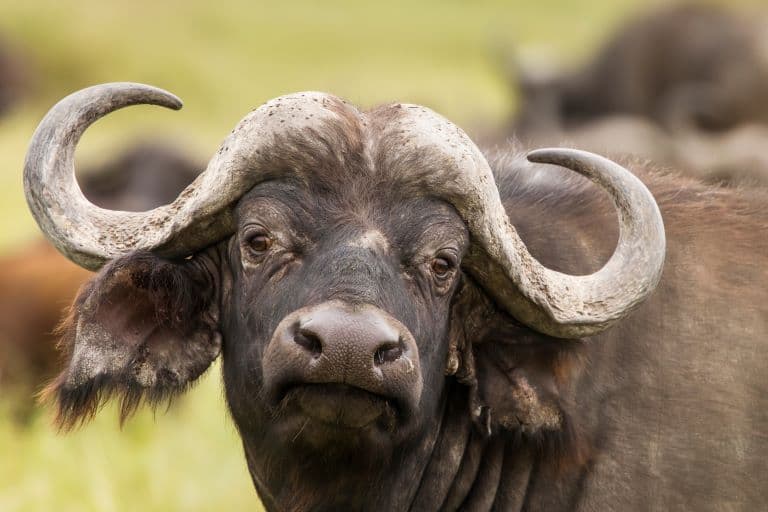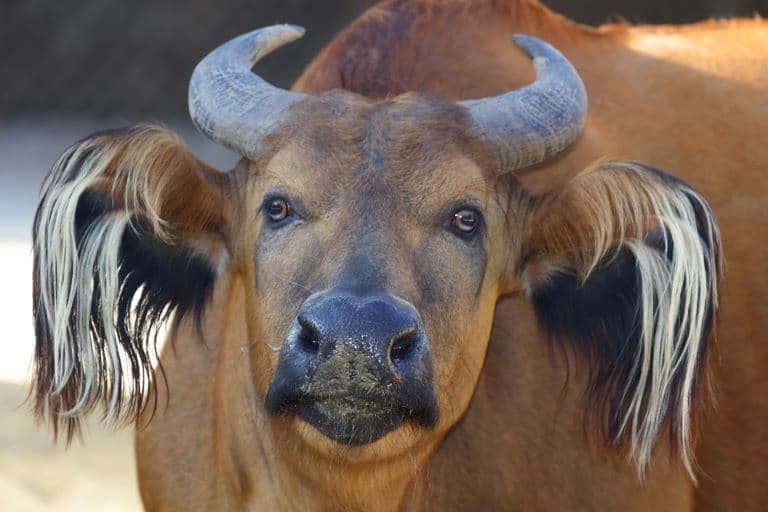African Buffalo Profile
Cows are unfortunately best known to most of us in the form of packaged food, but to those lucky enough to spend time with them, they’re known to be affectionate, intelligent, playful animals whose curiosity and cuddliness make them excellent therapy (as long as you don’t mind getting muddy).
But domestic cattle have come a long way from the Pleistocene mega-herbivores that once had to defend against the world’s most terrifying mammalian predators. Consequently, wild cows aren’t quite as mild-mannered and sweet.
Of all the threats to a gentle stroll through the African savanna, perhaps the most under-appreciated is the african buffalo.

African Buffalo Facts Overview
| Habitat: | Forest, Savanna, Shrubland, Grassland, Wetlands |
| Location: | Africa |
| Lifespan: | 18 in the wild. One captive female reached almost 33 years. |
| Size: | 1.6m tall, 3m long |
| Weight: | Up to 900kg in cape buffalo |
| Colour: | Black to reddish brown |
| Diet: | Grass and roughage |
| Predators: | Lions, leopards, cheetahs, wild dogs, humans, |
| Top Speed: | Possibnly up to 50km/h |
| No. of Species: | 1 |
| Conservation Status: | Near Threatened (IUCN) |
There is a wide range of African buffalo habitats across the continent. The four subspecies occupy quite diverse niches, from rainforest to savanna, and everything in between.
These are large, powerful herbivores with a terrifying mean streak, and while their reputation doesn’t seem to reach the wider world, for those living in Africa, they’re at least as frightening as the infamous hippo.
Interesting African Buffalo Facts
1. They’ve had a confused past
Originally grouped in the same genus as our domesticated friends, African buffalo have been shuffled around continually since the late 1700s.
By 1875, it was divided into three species, then it was grouped back into one. In 1935, there were 12 subspecies described, and at the moment, there are only four. It’s worth pointing out that at no point during the confusion was the species multiplying or dividing, it was simply the taxonomists who couldn’t make their minds up.
Now it’s a debate around whether there are two or four subspecies, based primarily on how recently various subpopulations diverged from one another. 1
2. There are four Subspecies
The four proposed subspecies are quite different from one another, so it’s hardly surprising that it’s taken a long time to figure out what’s going on. Each has its own distinct look and habitat, but all are very closely linked genetically.
The Cape buffalo is the largest, extending from Ethiopia in the East, all the way down to South Africa. This is the most notorious and well-known of the lot.
In the West, there’s a different population, the West African savanna buffalo. This one occupies Senegal to CAR, as far west as Nigeria.
Between the two is the appropriately named Central African buffalo, occupying DRC all the way over to Western Ethiopia.
Then, the forest buffalo is sort of dotted about all over the place, with populations mostly concentrated in the West and Central regions. Pockets of these extend to the East, to Uganda and Rwanda, but their numbers have declined substantially due to deforestation in these countries.
They’re all different in size and colour, and even their horns are varied, with the Cape buffalo having distinctive curved horns and bosses that make them look like those ridiculous court wigs.
As you’d expect, the forest buffalo is the smallest and has swept-back horns that are less likely to snag on trees.

3. They’re social
As cows, all subspecies are greatly social, and likely have complex emotional capacities. Forest buffalo are even restricted in their range by the need for communal resting places, making thick jungles inappropriate for the group.
As such, they choose a forest with clearings, so they can all rest together and keep one another company.
This species has at least ten recorded, distinctive vocalisations, representing different commands and communications. 2

4. They’re grass specialists
Buffalo, like domestic cattle, are ruminants. This means they heavily process their food and produce a thick brown custard out the back end.
Rumination is an adaptation to eating grass, which is impossible for many mammals to digest. Being heavy on protective cellulose, grass needs to be thoroughly degraded to access the nutrients inside, and this is impossible with a normal stomach, which is why it comes out of a horse looking very similar to the way it went in.
Buffalo have specifically adapted chambers in their gut for this, and their long, prehensile tongues grab and tear at grasses, while their teeth are evolved for grinding it up as much as possible. Once swallowed, this will ferment a bit and then be returned to the mouth for a second round of grinding.
Large individuals may consume more than 15kg of this stuff a day, and despite its apparent lack of protein, can pack on up to hundreds of kilos of muscle on such a diet.
This also makes them significant ecosystem engineers, maintaining forest clearings, spreading seeds, and trampling their nutrient-rich bullshit all over the plains.

5. They’re extremely dangerous
This peaceful-sounding life belies a tremendous level of aggression in the species, and the buffalo is not to be approached lightly.
Some reports assign this species the title of most deadly mammal on the continent, and it is for sure a bigger threat on land than the infamous hippo.
In some circles, buffalo are known as “widowmakers” or the “Black Death”, and are thought to attack more people by far than the classic predators like lions or leopards. They’re also better at killing when they do attack, with around a 50% chance of death.
This obviously depends on the area, and hippos are the biggest threat in the water, particularly at night. On the other hand, elephants in the forest are particularly scary animals and likely to have a much higher chance of squishing a person.
Regardless of their exact ranking, African buffalo are extremely aggressive and highly dangerous animals, and some hunters report them chasing down their foes even after being shot.
This heightened aggression is common in African animals and feeds into the hypothesis that animals which evolved alongside humans evolved to be highly dangerous in response to the predation risk that humans posed.
It might also explain why, when you take a buffalo out of the wild, they live a lot longer. Wild buffalo live approximately 18 years, while the captive record is more than twice that. 3

6. They’re being bred successfully in captivity
While African buffalo are disease vectors for livestock pathogens like foot and mouth, some governments are supporting the disease-free breeding of captive buffalo to replenish areas where they’ve been wiped out by cattle farmers.
Captive mothers have their calves taken away and placed under the surrogate care of domestic dairy cows, who are known to be exceptionally caring mothers.
Buffalo breeding is now a large industry and captive buffalo now live happily all over the world. While populations in Australia seem to be doing well, San Diego Zoo had to abandon its breeding programs due to high mortality rates.
7. They’re in decline
The success of captive breeding programs can’t be understated in its importance to the future of the species. In the wild, buffalo populations all over the continent are in decline, and the species is listed as Near Threatened.
Habitat loss and fragmentation are primary threats, particularly from animal agriculture, by way of forest clearing.
Poaching in protected areas is also a problem, as is big game hunting, and buffalo struggle with drought, which is increasing as a result of climate change. 4
African Buffalo Fact-File Summary
Scientific Classification
| Kingdom: | Animalia |
| Phylum: | Chordata |
| Class: | Mammalia |
| Order: | Artyodactyla |
| Family: | Bovidae |
| Genus: | Syncerus |
| Species: | Caffer |
Fact Sources & References
- Melleti, Mario (2014), “Ecology, Evolution and Behaviour of Wild Cattle”, Sci-Hub.
- M. Melletti (2006), “Habitat preferences of the secretive forest buffalo (Syncerus caffer nanus) in Central Africa”, Zoological Society of London.
- Adrian Treves (1998), “Risk and opportunity for humans coexisting with large carnivores”, Faculty Nelson.
- “African Buffalo”, IUCN Red List.
